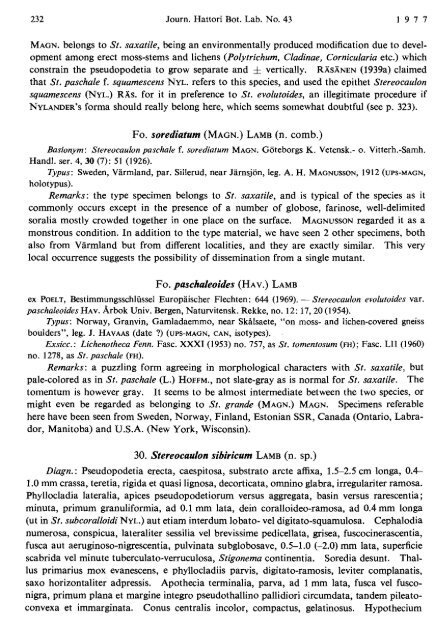A CONSPECTUS OF THE LICHEN GENUS STEREOCAULON ...
A CONSPECTUS OF THE LICHEN GENUS STEREOCAULON ...
A CONSPECTUS OF THE LICHEN GENUS STEREOCAULON ...
You also want an ePaper? Increase the reach of your titles
YUMPU automatically turns print PDFs into web optimized ePapers that Google loves.
232 Journ. Hattori Bot. Lab. No. 43 1977<br />
MAGN. belongs to St. saxatile, being an environmentally produced modification due to development<br />
among erect moss-stems and lichens (Polytrichum, Cladinae, Cornicularia etc.) which<br />
constrain the pseudopodetia to grow separate and f vertically. RASANEN (1939a) claimed<br />
that St. paschale f. squamescens NYL. refers to this species, and used the epithet Stereocaulon<br />
squamescens (NYL.) RKs. for it in preference to St. evolutoides, an illegitimate procedure if<br />
NYLANDER'S forma should really belong here, which seems somewhat doubtful (see p. 323).<br />
Fo. sorediatum (MAGN.) LAMB (n. comb.)<br />
Basionym: Sfereocaulon paschale f. sorediafum MAGN. Goteborgs K. Vetensk.- o. Vitterh.-Samh.<br />
Handl. ser. 4, 30 (7): 51 (1926).<br />
Typus: Sweden, Varmland, par. Sillerud, near Jarnsjon, leg. A. H. MAGNUSSON, 1912 (UPS-MAGN,<br />
holotypus).<br />
Remarks: the type specimen belongs to St. saxatile, and is typical of the species as it<br />
commonly occurs except in the presence of a number of globose, farinose, well-delimited<br />
soralia mostly crowded together in one place on the surface. MAGNUSSON regarded it as a<br />
monstrous condition. In addition to the type material, we have seen 2 other specimens, both<br />
also from Varmland but from different localities, and they are exactly similar. This very<br />
local occurrence suggests the possibility of dissemination from a single mutant.<br />
Fo. paschaleoides (HAv.) LAMB<br />
ex POELT, Be~timrnung~schIii~~e1 Europaischer Flechten: 644 (1969). - Stereocaulon evolutoides var.<br />
paschaleoides HAV. Arbok Univ. Bergen, Naturvitensk. Rekke, no. 12: 17,20 (1954).<br />
Typus: Norway, Granvin, Gamladaemmo, near Skilsaete, "on moss- and lichen-covered gneiss<br />
boulders", leg. J. HAVAAS (date ?) (UPS-MAGN, CAN, isotypes).<br />
Exsicc.: Lichenotheca Fenn. Fasc. XXXI (1953) no. 757, as St. tomentosum (FH); Fasc. LII (1960)<br />
no. 1278, as St. paschale (FH).<br />
Remarks: a puzzling form agreeing in morphological characters with St. saxatile, but<br />
pale-colored as in St. paschale (L.) H<strong>OF</strong>FM., not slate-gray as is normal for St. saxatile. The<br />
tomentum is however gray. It seems to be almost intermediate between the two species, or<br />
might even be regarded as belonging to St. grande (MAGN.) MAGN. Specimens referable<br />
here have been seen from Sweden, Norway, Finland, Estonian SSR, Canada (Ontario, Labrador,<br />
Manitoba) and U.S.A. (New York, Wisconsin).<br />
30. Stereocaulon sibiricum LAMB (n. sp.)<br />
Diagn. : Pseudopodetia erecta, caespitosa, substrato arcte affixa, 1.5-2.5 cm longa, 0.4-<br />
1.0 mm crassa, teretia, rigida et quasi lignosa, decorticata, omnino glabra, irregulariter ramosa.<br />
Phyllocladia lateralia, apices pseudopodetiorum versus aggregata, basin versus rarescentia;<br />
minuta, primum granuliformia, ad 0.1 mm lata, dein coralloideo-ramosa, ad 0.4 mm longa<br />
(ut in St. subcoralloidi NYL.) aut etiam interdum lobato- vel digitato-squamulosa. Cephalodia<br />
numerosa, conspicua, lateraliter sessilia vel brevissime pedicellata, grisea, fuscocinerascentia,<br />
fusca aut aeruginoso-nigrescentia, pulvinata subglobosave, 0.5-1.0 (-2.0) mm lata, superficie<br />
scabrida vel minute tuberculato-verruculosa, Stigonema continentia. Soredia desunt. Thal-<br />
lus primarius mox evanescens, e phyllocladiis parvis, digitato-ramosis, leviter complanatis,<br />
sax0 horizontaliter adpressis. Apothecia terminalia, parva, ad 1 mm lata, fusca vel fusco-<br />
nigra, primum plana et margine integro pseudothallino pallidiori circumdata, tandem pileato-<br />
convexa et immarginata. Conus centralis incolor, compactus, gelatinosus. Hypothecium

















